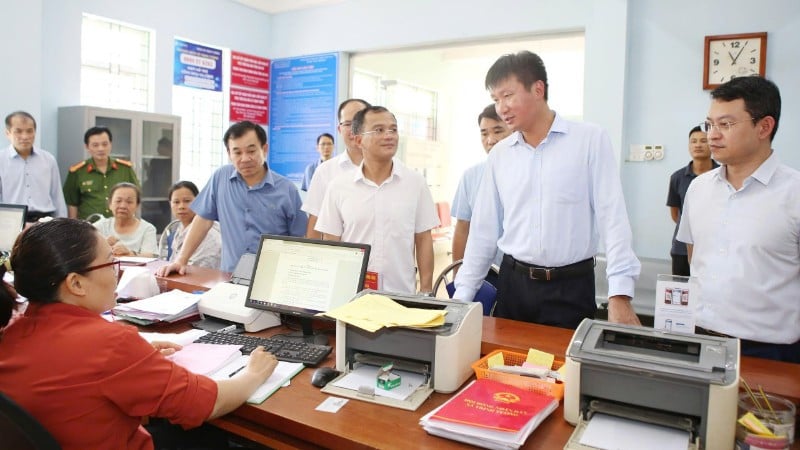
Reporter of Nhan Dan Newspaper had an interview with comrade Tran Huy Tuan - Chairman of Lao Cai Provincial People's Committee about the initial results, advantages, difficulties and key orientations for the two-level government model to operate effectively and practically in the new period.
Overcoming initial difficulties in the transition period
Reporter: After 4 months of implementing the two-level government model, how has the overall picture in Lao Cai changed, comrade?
Comrade Tran Huy Tuan: After 4 months of operating the two-level local government model since July 1, 2025, the People's Committee of Lao Cai province has directed departments, branches and People's Committees of communes and wards to complete the development and implementation of work programs and plans; promulgate working regulations and clearly assign tasks to each collective and individual according to assigned functions and authorities.
The implementation was carried out seriously, ensuring continuity, effectiveness and efficiency in state management, while maintaining smooth direction and administration of socio -economic development, ensuring national defense, security and maintaining social order and safety. Public Administration Service Centers at all levels operated in a disciplined manner, promptly resolved administrative procedures, creating convenience for organizations and individuals in accessing public services.
After rearranging and reorganizing the apparatus, Lao Cai province has reduced 24 provincial-level administrative organizations; 149 departments, branches and equivalent units; 3 provincial-level public service units; 51 public service units under departments, branches and district levels; reduced 18 district-level administrative units and 220 commune-level administrative units (183 communes, 19 towns, 18 wards).

Currently, the province has 17 departments and branches; 114 offices, branches and equivalents; 99 communes and wards (including 89 communes and 10 wards) with 297 specialized departments and 99 public administration centers. 100% of specialized departments and administrative organizations in 99 communes and wards have been established and put into operation in accordance with regulations.
The Provincial People's Committee has directed the completion of positions, functions, tasks, and organizational structures of departments, branches, and public service units; communes and wards have also issued working regulations for the 2021-2026 term. The Department of Home Affairs presides over the appraisal of the project to approve job positions and the structure of civil servant and public employee titles of administrative and service agencies, ensuring completion in the fourth quarter of 2025.
The work of arranging and assigning cadres, civil servants and public employees has been carried out promptly. Up to now, 100% of leaders, managers and 99% of professional and technical civil servants at the new commune-level administrative units have met the standards of professional qualifications and political theory. In general, the team of cadres, civil servants and public employees after the merger basically meets the job requirements, adapts quickly to the new management model; many people have promoted their capacity, sense of responsibility, proactively studied and practiced skills to complete their tasks well.
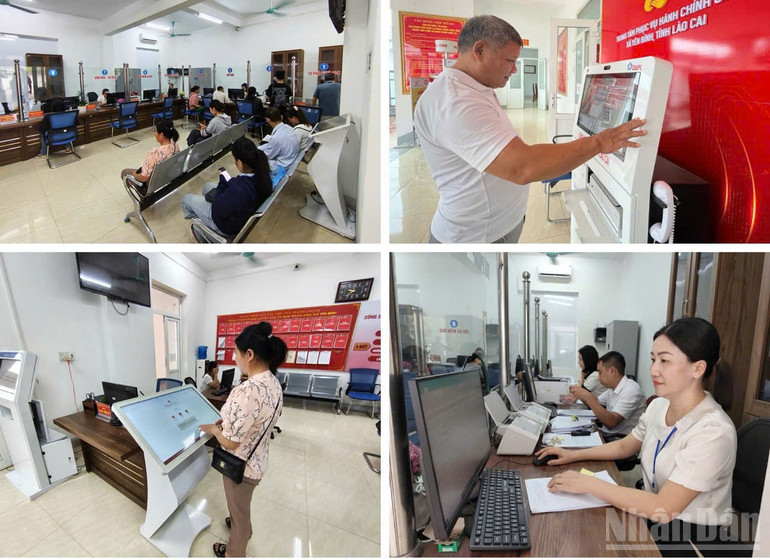
Some officials are still confused due to the expansion of the area, the increase in population, the fragmented terrain, and the difficult transportation, but these are only the initial difficulties in the transition period. The two-level government apparatus has been operating stably, ensuring clear people, clear work, clear responsibilities, affirming the correctness of the policy of streamlining the organization and innovating the management method.
Proactively deploy many solutions synchronously
Reporter: To make this model truly go into depth and promote its effectiveness, what key solutions has the province implemented, sir?
Comrade Tran Huy Tuan: To make the two-level government model effective, Lao Cai province has proactively developed specific plans, issued timely directives, and synchronously deployed many solutions to ensure unity, effectiveness, and efficiency in the operation of the apparatus.
First of all, the province has done a good job of propaganda in the political system, creating a high consensus among cadres, party members and people. The arrangement of administrative units and the construction of a two-level government model is a major policy, with profound significance in streamlining the organizational apparatus, streamlining the payroll, reducing administrative costs and creating a unified development space, overcoming the situation of division, scattered and fragmented investment.
Second, perfect the legal system regulating the functions, tasks, powers and methods of operation of local governments; thoroughly overcome overlaps and duplications; eliminate intermediate levels, ensure smooth, effective and efficient operations, and bring the government closer to the people.
Third, clearly define the tasks and powers of each level: the provincial level focuses on building mechanisms, policies, strategies, planning, macro-management, and handling inter-regional and inter-sectoral issues; the commune level organizes policy implementation, directly serves the people, solves community problems, and provides essential public services.
Fourth, improve the qualifications, professional capacity and expertise of the team of cadres, civil servants and public employees through training courses, fostering, equipping knowledge and skills to operate the new government model; review and evaluate the quality of cadres according to job position requirements, and arrange personnel in conjunction with streamlining the payroll and restructuring the team.
Fifth, strengthen democracy and social supervision, promote the role of people in supervising government activities, contribute to strengthening trust, and enhance the service responsibility of the state apparatus.
Sixth, promote the application of information technology and digital transformation, considering this the key to improving the quality of governance, serving people faster, more transparently and more effectively.
Thanks to synchronous implementation, the two-level government model has initially brought about positive results: the apparatus operates smoothly, efficiency is significantly improved; many administrative procedures are resolved quickly at the grassroots level, reducing inconvenience for people and businesses; the sense of responsibility and capacity to perform public duties of the staff are significantly improved; reasonable decentralization and authorization help promote the initiative and creativity of the commune level, and strengthen supervision from the provincial level.
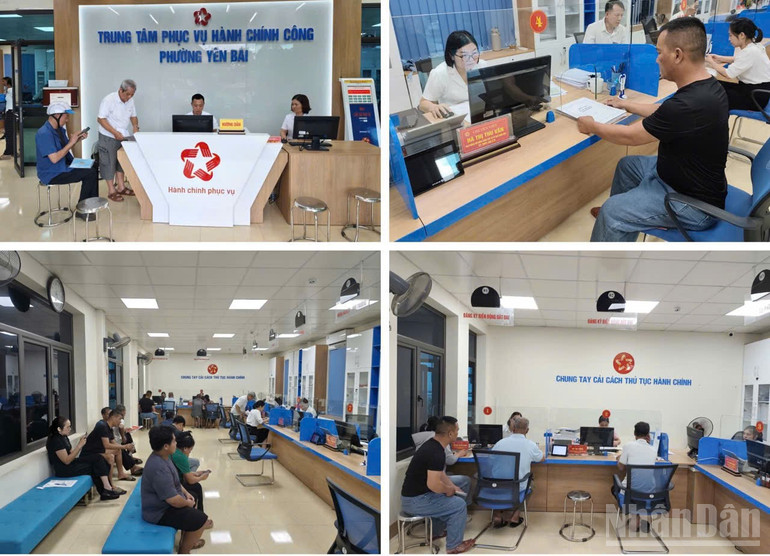
Focus on removing obstacles to improve management efficiency
Reporter: From practical leadership and management, how do you evaluate the advantages and difficulties in the process of implementing the new model?
Comrade Tran Huy Tuan: Implementing Resolution No. 18-NQ/TW dated October 25, 2017 of the 12th Central Executive Committee on continuing to innovate and reorganize the political system to be streamlined, effective and efficient, along with the Central's instructions on the two-level government model, the Lao Cai Provincial Party Committee and People's Committee have identified this as a particularly important task, to be carried out with a spirit of urgency, tightness and synchronization from the province to the grassroots level.
After 4 months of implementation, the Party committees and authorities at all levels have operated stably, clearly affirming the correctness of the major policy. The political system has operated relatively smoothly, the specialized agencies at the provincial level and 99 administrative units at the commune level have been put into order, with clear people, clear work, clear responsibilities, and no gaps in direction and management.
The staff and civil servants are assigned appropriately, have stable mindsets, and actively perform their tasks. Coordination between agencies and units after the merger is not disrupted, ensuring unity and harmony. Facilities and information technology infrastructure are reviewed and arranged promptly, meeting the requirements of operating the apparatus. Political security and social order and safety are maintained; citizen reception and petition handling are carried out seriously, without hot spots, complicated complaints, or large crowds.

More importantly, the consensus among cadres, party members and people continues to be consolidated; the trust of all classes of people in the leadership of the Party and government is enhanced. The arrangement of administrative units has created new momentum for the province's political system to innovate management methods, reform administration, and better serve the people and businesses.
However, in addition to the advantages, the province still faces some difficulties: The Central Government has not yet officially assigned the payroll to provincial and commune-level agencies and units according to type, making it difficult to determine the payroll at the end of the period; facilities and working equipment of some communes are still lacking, especially communes with special difficulties; the land database is not synchronized, lacking connections between levels and sectors, causing difficulties in information management and processing; land administrative procedures are still complicated, people and businesses have to travel a lot, wasting time. These are the issues the province is focusing on solving to improve governance efficiency.

Reporter: Digital technology is considered an important driving force in the operation of two-level government. How has Lao Cai implemented this content, comrade?
Comrade Tran Huy Tuan: Lao Cai province has synchronously deployed the information technology system from the province to the commune. Currently, 95% of commune-level units operate the information system for handling administrative procedures (electronic one-stop shop), synchronously connected with the document management system, work management, shared database and official email system.
The province has promoted the use of paperless meeting software, digital signatures and work management in the digital environment. Many administrative procedures have been decentralized and authorized to communes and wards for online processing; many localities have deployed online public services at levels 3 and 4. In the field of science and technology, 121/194 administrative procedures have been decentralized to the commune level.
Attention has been paid to training and fostering digital skills for grassroots officials; the province has organized many training courses and formed community digital technology teams in villages and hamlets to support people in carrying out administrative procedures online, gradually forming the habit of working in a digital environment.
Besides positive results, there are still difficulties: information technology infrastructure is not uniform, especially in mountainous areas; many communes lack equipment such as computers, printers, scanners, digital signatures; Internet connection is unstable; a number of older officials are not familiar with technology; people in rural areas and ethnic minority areas have limited digital skills, and the habit of making paper documents is still common. In addition, lack of financial resources to invest in equipment and software has made the progress of digital transformation in some communes slow.
However, digital transformation is still a bright spot in Lao Cai's administrative reform. The application of information technology has contributed to improving the efficiency of the apparatus, improving service quality, shortening the gap between the government and the people, towards the goal of building a digital government and digital society in the province.
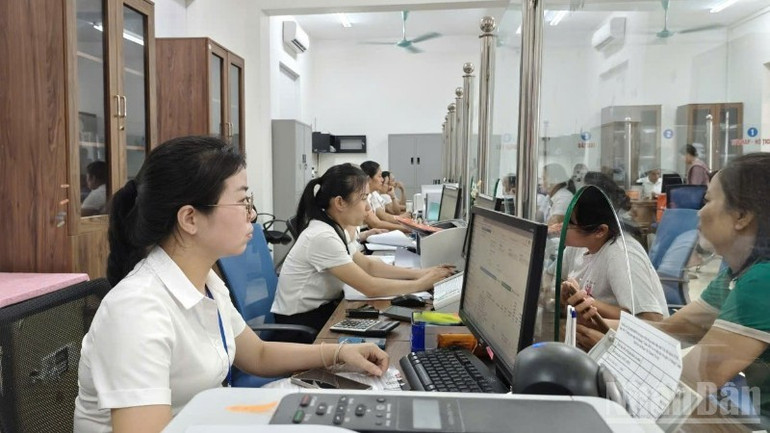
Reporter: Could you please tell us, in the coming time, to ensure the two-level government model operates stably and sustainably, what key tasks will Lao Cai province focus on?
Comrade Tran Huy Tuan: The province will continue to issue legal documents, decisions and directives to promptly specify the regulations of the Central Government, especially those related to decentralization, authorization and new working regimes.
At the same time, review, mobilize, and reasonably arrange cadres, civil servants, and public employees after the merger; organize training courses, foster specialized skills, improve management and operation capacity according to the new model; promote the settlement of regimes and policies for cadres, civil servants, and employees according to Decree No. 154/2025/ND-CP and Resolution No. 07/2025/NQ-CP of the Government.
The province builds a synchronous and close coordination mechanism between the People's Committee and Party agencies, the Fatherland Front, and socio-political organizations; strengthens the connection and coordination of responsibilities between specialized agencies and lower-level People's Committees, ensuring work progress and quality, serving the people quickly and effectively.
At the same time, the province continues to invest in digital transformation infrastructure, perfect shared databases, promote administrative reforms, improve the quality of cadres and civil servants, and meet the requirements of serving the people in the new period.
Reporter: Thank you very much , comrade!
Source: https://nhandan.vn/mo-hinh-chinh-quyen-hai-cap-o-lao-cai-bo-may-tinh-gon-van-hanh-thong-suot-phuc-vu-nhan-dan-tot-hon-post919901.html



![[Photo] President Luong Cuong receives US Secretary of War Pete Hegseth](https://vphoto.vietnam.vn/thumb/1200x675/vietnam/resource/IMAGE/2025/11/02/1762089839868_ndo_br_1-jpg.webp)

















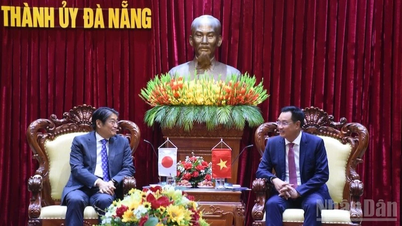

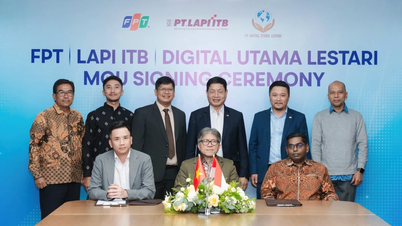
![[Video] National teams speed up preparations for SEA Games 33](https://vphoto.vietnam.vn/thumb/402x226/vietnam/resource/IMAGE/2025/11/03/1762149856348_chuan-bi-sea-games-33-282-jpg.webp)
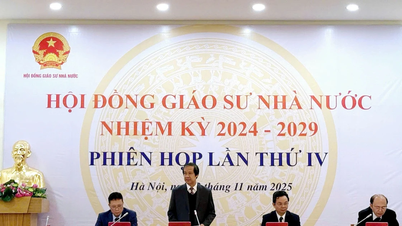























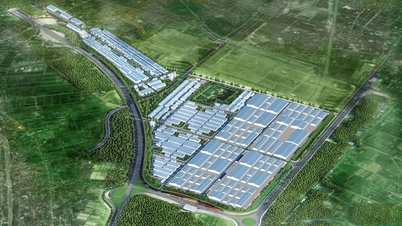












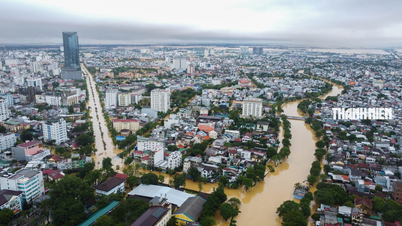





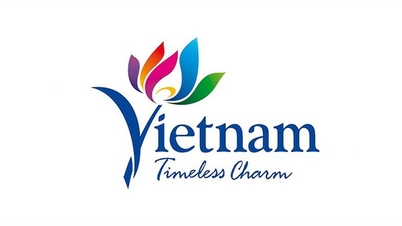







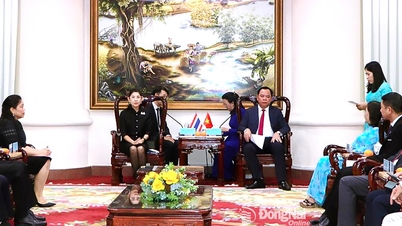







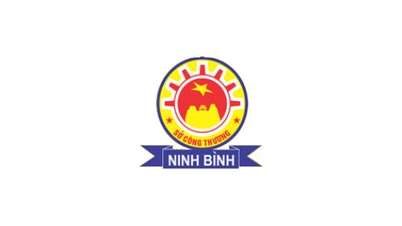

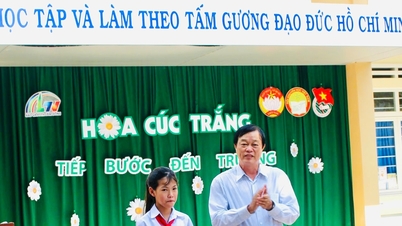













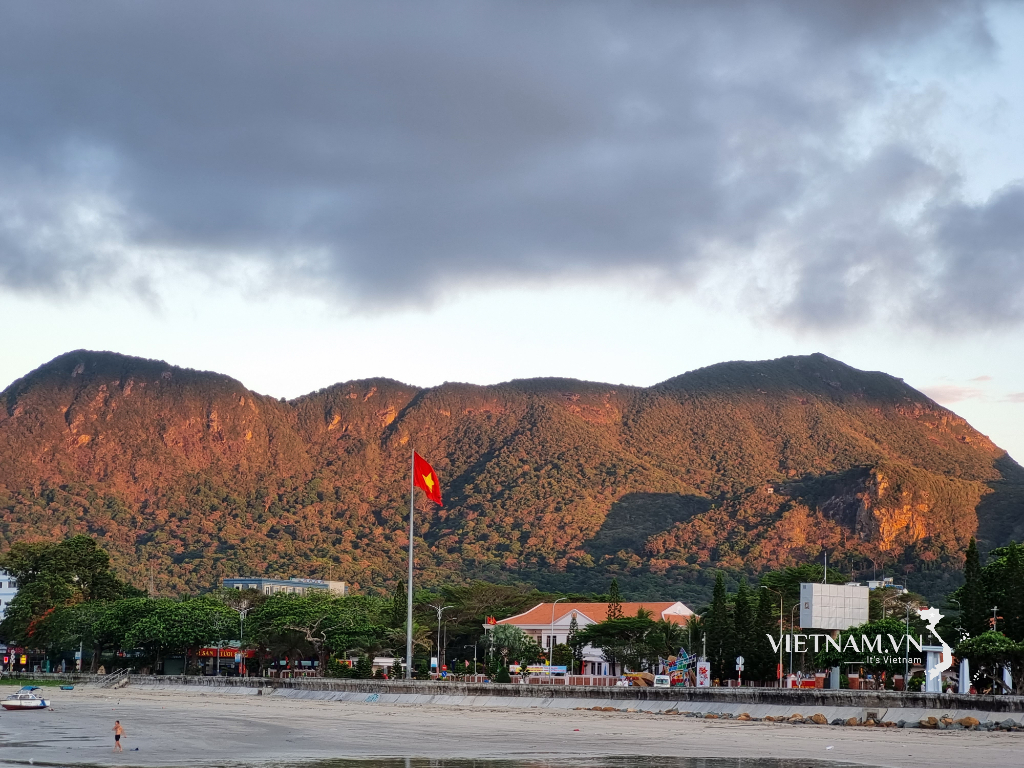


Comment (0)